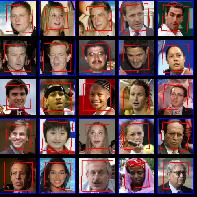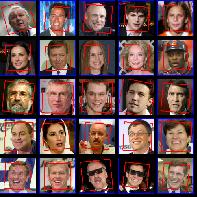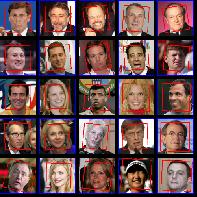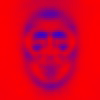Face Alignment
Many recognition algorithms depend on careful positioning of an object into
a canonical pose, so the position of features relative to a fixed coordinate
system can be examined. Generally, this positioning is done either manually
or by training a class-specialized learning algorithm with samples of the
class that have been hand-labeled with parts or poses. Due to the amount of
supervision required by these methods, the alignment step of the recognition
pipeline (below) is often ignored, under the assumption that the initial
detection will perform rough alignment. In this project, we
explore methods for aligning face images using low levels of supervision,
for instance only using poorly aligned face images given as the output
of a Viola-Jones face detector. We measure performance by comparing the
recognition results using the images from detection compared with the
aligned faces.
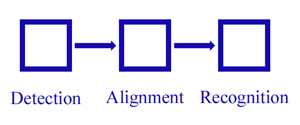
Recognition Pipeline
Faculty
Graduate Students
Animations of congealing on face images:
Animations of entropy of distribution fields during congealing:
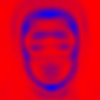
final
Source Code: here
References
-
Gary B. Huang, Marwan Mattar, Honglak Lee, Erik Learned-Miller.
Learning to Align from Scratch
Advances in Neural Information Processing Systems (NIPS), 2012.
[pdf]
- Gary B. Huang, Marwan Mattar, Tamara Berg, and Erik Learned-Miller.
Labeled Faces in the Wild: A Database for Studying Face Recognition in Unconstrained Environments.
Faces in Real-Life Images Workshop in European Conference on Computer Vision (ECCV), 2008.
[pdf]
- Gary B. Huang, Vidit Jain, and Erik Learned-Miller.
Unsupervised joint alignment of complex images.
International Conference on Computer Vision (ICCV), 2007.
[pdf]
- Gary B. Huang, Manu Ramesh, Tamara Berg, and Erik Learned-Miller.
Labeled Faces in the Wild: A Database for Studying Face Recognition in Unconstrained Environments.
University of Massachusetts, Amherst, Technical Report 07-49, October, 2007.
[pdf]
[LFW homepage]


